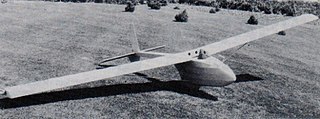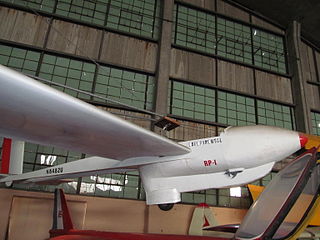Related Research Articles

The Glasflügel 604 is a high-wing, T-tailed, single seat, FAI Open Class glider that was designed and produced in West Germany by Glasflügel starting in 1970.
The IKV-3 "Kotka" is an FAI Open Class glider that was designed by Tuomo Tervo and Jorma Jalkanen. The prototype first flew in 1966. It was produced initially by IK-Vasama and KK. Lehtovaara.

The Laister LP-15 Nugget is an American single-seat, high-wing glider designed by Jack and Bill Laister for the FAI Standard Class.

The Hall Vector 1 is an American high-wing, ultralight glider that was designed by Stan Hall for serious cross-country flights.

The Bikle T-6 is an American, mid-wing, single seat, glider designed by Paul Bikle and based upon the design of the Schreder HP-14. Even though only one T-6 was built it is noted as the most tested and studied glider with complete data published. It has been used extensively as a comparative reference glider for evaluating other designs during in-flight comparisons.

The Schreder HP-17 was an American mid-wing, V tailed, single seat, experimental glider designed by Richard Schreder to test a new airfoil section.
The Gehrlein GP-1 is an American mid-wing, single seat FAI Standard Class glider that was designed by Jay and Rod Gehrlein and first flown in July 1968.
The Monaghan Osprey is an American mid-wing, single-seat, T-tailed, FAI Standard Class glider that was designed and constructed by Richard C. Monaghan of Pearblossom, California.
The Parker RP9 T-Bird is an American, high-wing, T-tailed, single-seat, FAI Open Class glider that was designed and constructed by Ray Parker between 1956 and 1962.
The Whigham GW-5 is an American mid-wing, single seat, FAI Standard Class glider that was designed and constructed by Gene Whigham, a retired flight test engineer for Convair.
The Vogt Lo-170 is a West German high-wing, FAI Open Class single seat glider that was designed by Alfred Vogt.
The Celair GA-1 Celstar is a South African mid-wing, single-seat, aerobatic glider that was designed by Pieter Celliers and produced by his company, Celair (Pty) Limited.
The Hermanspann Chinook is an American mid-wing, two-seat, experimental research glider that was designed and constructed by Fred Hermanspann and Art Penz.
The Marsden Gemini is a Canadian mid-wing, T-tailed, two-seats in side-by-side configuration, experimental research glider that was designed and constructed by David Marsden at the University of Alberta, first flying in 1973.

The Masak Scimitar was an American mid-wing, single-seat glider that was designed and constructed by Peter Masak.

The PZL Krosno KR-03 Puchatek is a Polish mid-wing, T-tailed, two-seats-in-tandem, glider that was designed by Jerzy Krawczyk and Eugeniusz Pelczar and produced by PZL Krosno, first flying in 1985.

The Rensselaer RP-1 is an American low-wing, single-seat, foot-launchable glider that was designed and produced by the Rensselaer Polytechnic Institute of Troy, New York.
The Rensselaer RP-3 is an American mid-wing, T-tailed single-seat, glider that was designed by Brian E. Thompson and produced by the Rensselaer Polytechnic Institute of Troy, New York.
The Manuel Hawk was a homebuilt single-seat glider designed and constructed in the UK around 1970. Only one example was flown.
The Akaflieg Braunschweig SB-8 is an experimental, single-seat, high performance glider built in Germany in the 1960s, constructed largely from glass fibre skin over built up balsa wood structure. Two were built; the second of which was later fitted with a high aspect ratio (30:1) wing, becoming the Akaflieg Braunschweig SB-9 Stratus.
References
- 1 2 3 4 5 6 7 Activate Media (2006). "Bird Flight Machine Farrar". Archived from the original on 9 June 2007. Retrieved 10 August 2011.
- 1 2 3 Federal Aviation Administration (17 August 2019). "Make / Model Inquiry Results N6437" . Retrieved 17 August 2019.
- ↑ Lednicer, David (2010). "The Incomplete Guide to Airfoil Usage". Archived from the original on 20 April 2010. Retrieved 1 August 2011.